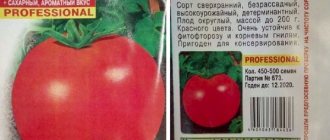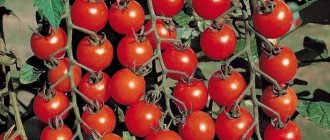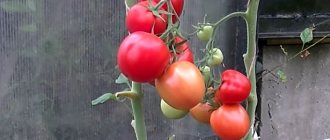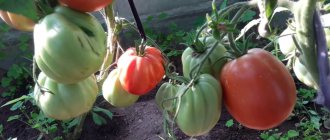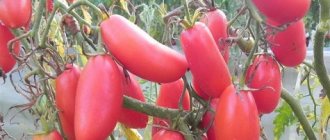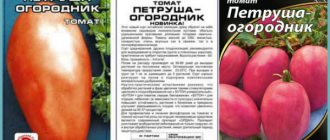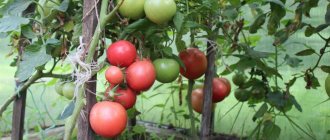There is probably no person who doesn’t like tomatoes. This juicy, fleshy berry is not only tasty, but also very healthy. It is rich in antioxidants, potassium, and other beneficial microelements. They even make hair masks from it - it’s so useful.
Breeders have always surprised us with their ingenuity. To some extent, they can be considered artists, because how many experiments they need to go through in order to ultimately get the variety that was originally intended.
As for the Siberian regions, it was much more difficult here: the climate changes often, it can be harsh, and therefore Barnaul breeders had to try hard to get a good and unpretentious variety. And they succeeded. The new hybrid was named Demidov tomato.
Description of the variety
The Demidov tomato variety is registered and included in the State Register of the Russian Federation.
- Recommended for growing mainly in open ground. Adapted for the northern regions (Volga-Vyatka, and even West Siberian).
- Refers to mid-season varieties. Fruit ripening begins 100-110 days after the appearance of the first shoots.
- The plant belongs to a determinate species and is not distinguished by strong branching. The height of the bushes can reach up to 65 cm.
- The stems bear small dark green leaves. They are shaped like potato leaves.
- The stem is strong, so there is no need to tie it up.
- The plant is standard.
- This tomato variety was created using a non-hybrid method and does not have F1 hybrids.
- Grows well in any weather conditions, maintaining a stable ovary process.
- The bush is formed into 1-2 stems, and the remaining stepsons should be removed.
- The first simple inflorescence appears above the 6-7th leaf, and the next ones appear every 1-2 leaves. The stalks have joints.
- High yield of vegetables. From 1 sq.m. You can collect up to 15 kg of fruit. Of the total mass of tomatoes collected, 98% are high-quality products.
- The Demidov variety is resistant to nightshade diseases. However, if watering is poor, they can become infected with blossom end rot.
Video: Demidov tomato variety, advantages and disadvantages
This is a natural variety of tomato. Therefore, we recommend taking seeds from a ripe fruit and using them for planting in subsequent seasons.
If you grew Demidov tomatoes, please write whether you liked them or not. What was the yield and taste of the fruit? Will you grow them again? How do you rate the disease resistance of this tomato? Briefly describe what, in your opinion, are the advantages and disadvantages of this tomato. If possible, attach to the comment a photo of the entire bush as a whole or individual fruits that you grew. Thank you!
Your reviews of the Demidov tomato and additions to the description will help many gardeners evaluate this variety more objectively and decide whether it is worth planting or not.
A site about tomato varieties with truthful reviews from gardeners - Tomatland.
Fruit characteristics
- The fruits are characterized by a rounded shape, on which slight ribbing is visible.
- Vegetables in an unripe state have a greenish tone, and the stalk has a dark green color. Ripe fruits are pink.
- A tomato inside has 4 or more seed chambers that contain seeds.
- Dry matter in tomatoes is from 3.5 to 4.3%.
- The weight of one vegetable can vary from 80 to 120 g.
- In suitable conditions they are stored well. Unripe tomatoes ripen well in a warm room.
Pest and disease control
Tomato Demidov is rarely affected by diseases or pests. If proper agricultural practices and simple prevention rules are followed, it does not suffer from infections. To do this, it is necessary to carry out at least one treatment with a fungicide - a few days before transferring the seedlings to open ground. You can use any available tool:
- Bordeaux mixture;
- "Fitosporin";
- "Tattu";
- "Profit";
- "Topaz".
If pests (aphids, Colorado potato beetles and others) are detected, Demidov tomato bushes should be treated with insecticides:
- "Aktellik";
- "Confidor";
- "Spark";
- "Green Soap"
Folk remedies also give a good effect. For example, bushes can be treated with a weak solution of baking soda, an infusion of onion peels, finely chopped garlic, a decoction of celandine or other liquids.
Important! Treatment is carried out only in dry, windless weather, if possible late in the evening. If an insecticide or fungicide was used, it is allowed to begin harvesting no earlier than after 5-10 days.
Features of cultivation
Seeds for seedlings begin to be sown in the last ten days of March or the first ten days of April. Trays with seeds should be covered with film to create a greenhouse effect. After the sprouts appear, the covering is removed and the container with the seedlings is transferred to a lighted place.
When 1-2 leaves appear on the sprouts, they are picked into separate containers. While the seedlings are developing, during this time you need to add a complex of mineral fertilizers to the soil 2-3 times. 7-10 days before the plants are moved to a permanent place, they should be hardened off.
Seedlings are planted in open ground in early June. Seedlings, the distance between which is kept at 50 cm, are planted in 1 row, and the row spacing is left at least 60 cm. If a greenhouse is used, tomatoes are planted in mid-May.
More information about growing tomatoes is described in the article: Technology of growing tomatoes. Secrets of planting and care
You might be interested in: How to properly plant tomatoes in a greenhouse: bush formation diagram, care features, photos and videos
Useful information: How to properly tie tomatoes in open ground: the best methods, step-by-step photo and video instructions
What you need to know about the agricultural technology of the Demidov variety
It is optimal to cultivate the Demidov variety using seedlings. To do this, the seeds should be sown in the last days of March or early April. Before germination, the container is covered with plastic film or glass.
Tomatoes "Demidov" are grown in seedlings
When the first shoots appear, the cover is removed, and the greenhouse itself is moved closer to the light source. When a pair of full-fledged leaves forms on the plants, the seedlings should be distributed into separate cups. Picking is very important for the growth and optimal development of the plant.
In mid-May, it is recommended to transplant the seedlings under film covers or into a greenhouse. The most suitable planting pattern for this vegetable crop is 50 x 60 cm.
When growing tomatoes of the Demidov variety, it is recommended to pay attention to the following recommendations:
- The need to fertilize 2 or 3 times during growth.
- The importance of hardening off seedlings before transferring them to a permanent location.
- Eliminating the possibility of sunburn on plant leaves.
Demidov tomatoes need high-quality watering, but after sunset
Proper watering is extremely important for these tomatoes. It is carried out with water heated during the day and settled strictly after sunset.
The Demidov tomato variety is an excellent vegetable crop that produces a good harvest. At the same time, gardeners will not have to do anything particularly complicated when caring for it.
Growing a tomato tree in open ground
Belonging to low-growing and weakly bushy tomato varieties, Demidov does not require much effort in forming bushes. Most often they are stepchildren, leaving 2–4 stepsons. However, this is not always done. Removing stepchildren on low-growing bushes very often leads to a noticeable decrease in yield. But at the same time, the ripening of fruits accelerates, their presentation improves and their size increases, so in each individual case, vegetable growers decide whether to plant a particular bush or not.
Low-growing determinate tomato bushes usually do not need staking. However, in the case of the described variety, which, having a high yield, may not withstand the weight of its own fruits, it is recommended to tie the bushes to reliable supports.
Each watering of the plant must be accompanied by mandatory loosening of the soil around the bushes to avoid the formation of a crust that interferes with the respiratory function of the root system. The same should be done after each rain. To stabilize the humidity and temperature conditions in the soil, it is recommended to mulch the soil around the bushes with straw, grass clippings or sawdust.
Find out if low-growing tomatoes are taking root.
How to grow seedlings
Demidovs are grown both with the help of seedlings and without them (the seeds are planted directly on the beds in May-June). In the first case, seed planting begins in 60–65 days.
Seed preparation
Agronomists recommend including 7 basic procedures in preparing seed material. When carrying them out, follow the sequence, but if any stage is uninteresting or seems difficult, just skip it and move on to the next one.
Start preparing a month before sowing:
- Calibration _ Empty the seeds from the package and examine them. For planting, select large, even seeds. Set aside small, crooked, empty ones to the touch - you won’t be able to get a good harvest from them. Test the seeds with a salt solution: add a tablespoon of salt to a glass of water and place the grains there. After 20 minutes, discard those that float to the surface; they will not sprout.
- Warming up . Dry the seeds. Place them in a cotton bag and hang it from the radiator for 2-3 weeks. Those who like to do everything quickly place the seeds on a cloth and place them on a cardboard sheet on a heating radiator. In this case, the duration of the procedure is from 36 to 48 hours. Some summer residents advise placing the seeds in a newspaper envelope, which is wrapped in cotton cloth and laid out on the radiator. This saves space and prevents seeds from being accidentally scattered.
- Disinfection . Prepare a 1% solution of potassium permanganate: add 1 g of potassium permanganate to 100 ml of water. For accurate measurements, use scales, since if the ratio is incorrect, there is a high risk of destroying the seed material. If this option does not work, try measuring the powder by eye. In this case, dissolve a teaspoon of potassium permanganate (6 g) in 2 glasses of water (600 ml). The duration of disinfection of tomato seeds is 20 minutes. The 1% solution is almost black in color, so don't be alarmed if the seeds become colored after soaking. Plant agronomy experts say that treating grains with a less concentrated solution will not have a disinfecting effect. After disinfection is completed, rinse the grains with running water.
- Sparging (oxygen saturation). Place the planting material in warm (+26 to +30 °C) water and stir every hour for 15–18 hours. For convenience, use an aquarium compressor. If the seeds begin to germinate, interrupt the procedure.
- Soaking . Place the seeds in warm water (from +26 to +30 °C) or a solution of a biostimulating drug. Experienced farmers prefer to use Zircon, Epin, sodium humate and Energen (in liquid form). The duration of the procedure is 12 hours. Summer residents also advise soaking seeds in aloe juice. To do this, wrap the leaves of the plant in paper and put them in the refrigerator for 2 weeks. Then squeeze out the juice and mix it in a 1:1 ratio with warm water. Soaking time is 24 hours.
- Hardening . Wrap the seeds in cloth and film and place on the bottom shelf of the refrigerator for 8 hours. Then place it in a room at room temperature for 8 hours. Repeat 5-6 times.
- Germination . Leave the seeds on gauze or cotton cloth in a flat bowl and moisten with warm water. The temperature of the room where the seeds will be located should not be lower than +21 °C. Make sure to keep the fabric damp at all times. If necessary, moisten it with water (+25 to +30 °C). When embryos 2-3 mm in size appear on the grains, begin planting.
Container and soil
Buy a container for seedlings in specialized stores or make one from scrap materials. Plastic cups, cut-off bottles, dairy product packaging, and PET cake lids are great for this.
Buy soil mixture at the store. The composition of the universal tomato soil includes:
- humus;
- peat;
- river sand.
You can prepare the soil mixture yourself by combining:
- garden soil - 1 part;
- non-acidic peat - 2 parts;
- sand - 0.5 parts;
- humus or sifted mature compost - 1 part.
Add wood ash or dolomite flour, sphagnum moss and fallen pine needles.
Before planting, treat the soil and containers with boiling water or a weak solution of potassium permanganate.
Sowing
Fill the containers 2/3 full with soil. Moisten the soil generously, make grooves 1 cm deep in it. Place the seeds at a distance of 2-3 cm from each other. Cover with a thin (1-2 cm) layer of soil and moisten the soil with a spray bottle.
Cover with plastic wrap (for small containers, use thin plastic bags) to create a greenhouse effect and place the containers in a dark and warm (+22 to +28 °C) place.
Growing and care
As soon as the first green heads appear from the ground, remove the film. Water the seedlings as the soil dries under the roots using a teaspoon or syringe. When two true leaves appear, plant the tomatoes in separate containers. Add mineral fertilizers to the new soil at the rate of 1 tbsp. spoon per 5 liters of soil. Dig the seedlings down to the cotyledon leaves.
10 days after picking, feed the seedlings with complex fertilizer. Add them every 14 days. 2-3 weeks before transplanting to the garden, start hardening off the tomatoes. In the first days, take it out into the open air for 3-4 hours, placing the containers in the shade. Gradually increase the time you spend outside and the amount of sunlight. 2-3 days before transplanting, leave the seedlings outside overnight.
Important ! Seedlings standing on a windowsill will lean towards the sun, so rotate the containers every day.
Carefully monitor the formation of inflorescences. It is advisable to transplant the plants to the site before the first flowers appear. Otherwise, the tomato takes a long time to take root, is delayed in development, and fruiting begins later than the date indicated by the manufacturer.
Harvesting and application
Tomatoes ripen at 101–109 days. The fruits are used fresh. They are not suitable for whole-fruit pickling. They are used to prepare lecho, sauces and juices for the winter. Demidov tomatoes tolerate transportation and long-term storage well, which is why they are often grown for sale by large farms.
Interesting ! You can collect seeds from tomatoes for further planting.
Possible diseases and pests, ways to get rid of them
Many nightshade crops suffer from various diseases, but the Dachnik tomato is an exception. But if the watering regime is violated, even this plant can develop blossom end rot. Therefore, it is important to add water in a timely manner and ensure that the soil around the bushes does not dry out. In most situations, tomato bushes do not suffer from pests. But sometimes it begins to infect the culture.
| Pests | Fighting methods |
| Thrips | The most effective drugs are Actellica and Karate. |
| Garden scoops | To get rid of pests you need to spray the plants with an insecticide. Danadim and Zolon are considered the best remedies. |
| Colorado beetle | It is very difficult to get rid of it, since this beetle adapts well to various poisons. Therefore, the most effective method of control is manual collection of the pest. You can also create optimal conditions for the reproduction of natural enemies of the Colorado potato beetle. These include praying mantises, ground beetles, and spiders. |
| rusty mite | The pest can be destroyed if you use the drugs Fufanon or Tamaron. |

